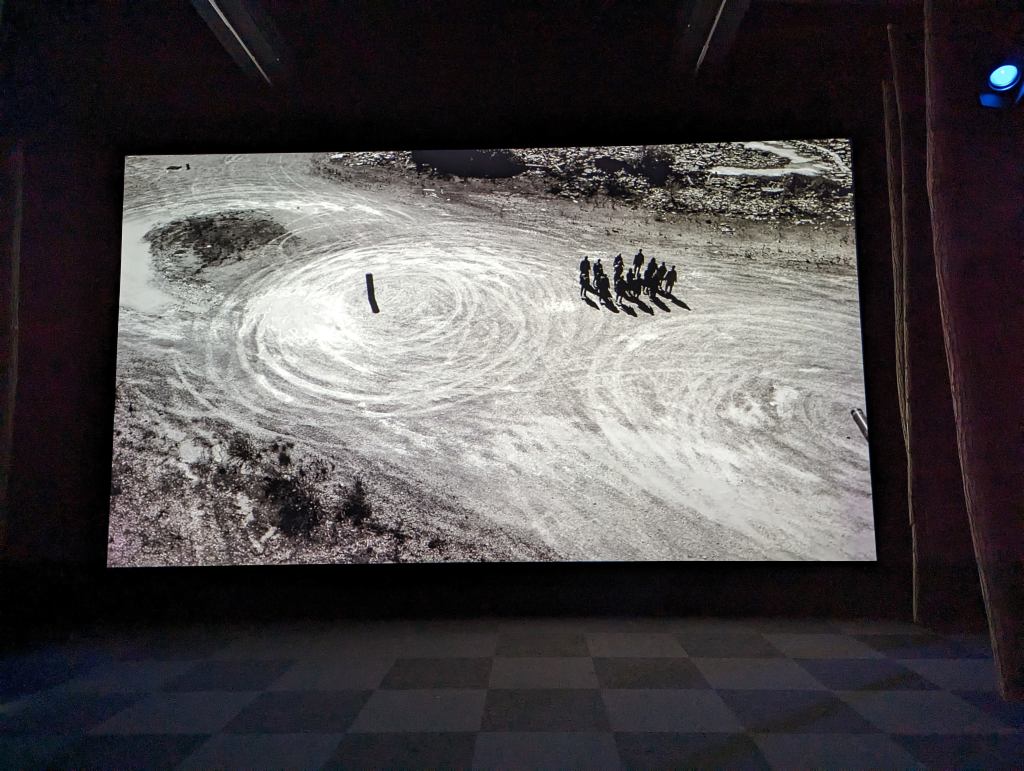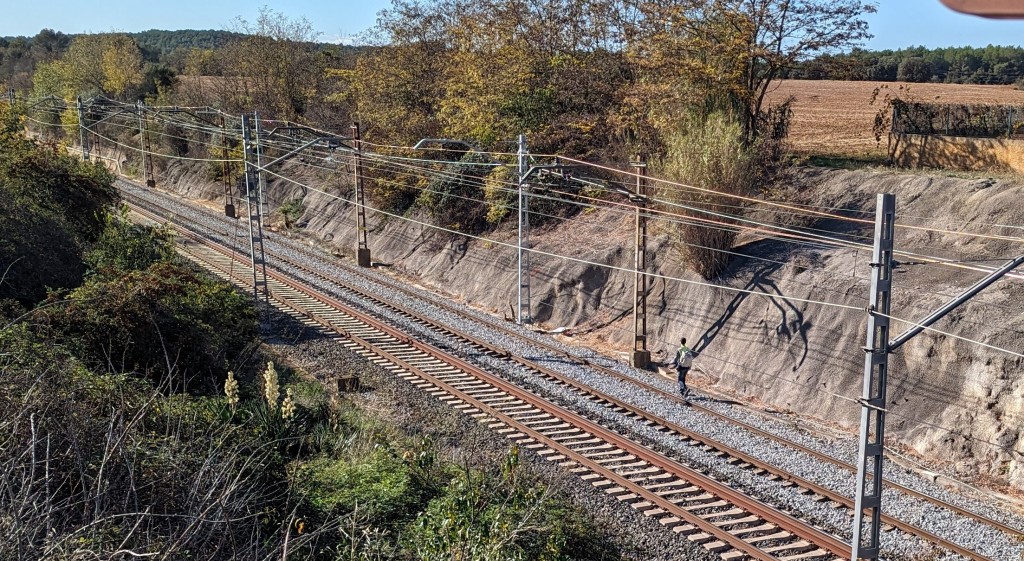The Bluebird Call by Mal Pelo at Bòlit, Centre d’Art Contemporani, Girona. In two parts: Bosc Tancat (‘Dense/Enclosed Forest’) in Bòlit_LaRambla, and Taller-Memòria in Bòlit_PouRodó.
“If the main driving force of our dynamic is walking then that of our identity is asking questions.”
Mal Pelo

In this video-art-light installation at the Bólit, Centre d’Art Contemporani in Girona, tall, straight tree trunks are suspended. Hanging off the ground without roots, they exist in an other-worldly, ghostly light in front of a large screen showing a black and white film. On that screen, people swarm slowly, alone and blank-faced, in step with each other. They walk rhythmically, turning at random intervals, sometimes in concert with others in the group. They walk and walk.
Based on a poem, Separation, by art critic, painter and writer, John Berger, the company state that the work is “about the ambivalence of the individual and the community”. Using the medium of contemporary dance in the broadest understanding of that word, and highly respected within the artistic community (they were directorial collaborators in the extraordinary Falaise by company, Baro d’evel, for example), Mal Pelo are the artistic co-directors, dancers and choreographers Maria Muñoz and Pep Ramis based in Girona.
Their film is set in bleak forests and abandoned industrial and rural wastelands where an assembly of overcoated, beanie-hatted people walk together. With arms swinging naturally or hands in pockets, they carry nothing, though we see them sharing sliced bread, offering it to each other when they make a meal stop. In Separation, Berger writes, “… in our hearts we carry everything …”.

Afterwards, they wind between trees, something we must do to get to one of the two chairs which invite us to sit and watch. There’s a sense these humans — for there is a homogeneity about them — are searching, and yet they seem aimless. Are they a tribe? An extended family? They wander individually, collect for a moment like a flock of ground-based birds arcing en masse, still moving, before separating again.
Stylistically, the collaborative choreography is reminiscent of the early pedestrian experiments of the Judson Dance Theater in the New York lofts of the ‘60s, harking back to the very early work of Simone Forti, Steve Paxton and Yvonne Rainer. This work marked an important departure from the dark auditoria, proscenium-arch theatres, in which dance had almost exclusively existe
d before that, to more quotidian spaces, to the studios and pavements of America. The participants often had no training, they were ‘ordinary’ people who were simply interested and willing to experiment. There was an anarchic spirit about the period.
The filming in Bosc Tancat is often from above, inverting our ground-based habit of looking up to see a skein of geese flying in formation, our normal way of seeing. At other times, the walkers move directly at the camera, passing by without acknowledging it. Walking away from us without pausing, they continue to walk as if forever, pacing without stopping. Are they in harmony? Are they moving away from home or life or land, or towards it?
The haunting, instrumental score in Dense Forest by Fanny Thollot, is interspersed with Berger’s poem, gently spoken. There are occasional silences, too, as if the wind has momentarily ceased though the movement is ever onwards.

Sitting amongst the ‘Dense Forest’ close up to the wall which is filled with this film, I am carried along the paths with the chorale, as if lacking a sense of autonomy. I feel as if I am slowly floating and looking down even when the lens is not, my wings outstretched, my seeing and hearing alert, but when the company eventually come to the end, it is at an edge. They collect at the top of a cliff, a vista ahead of them and there they sit with their backs to me, still, at last, and I am left, melancholy.
I am suddenly taken back to two occasions when I have witnessed single men walking along train tracks with no luggage. Once, in 2018 in north eastern Greece not far from the Turkish border, I was in a car witnessing through the window as we passed him walking into the distance. The other time was just last week in Cataluña when I stood on a bridge and looked over and down watching this tiny figure recede.
The actions, the behaviour of the performers in the carefully chosen landscapes of Bosc Tancat have a timelessness and as I leave I feel a deep connection to them.

© All photos are by the author

















